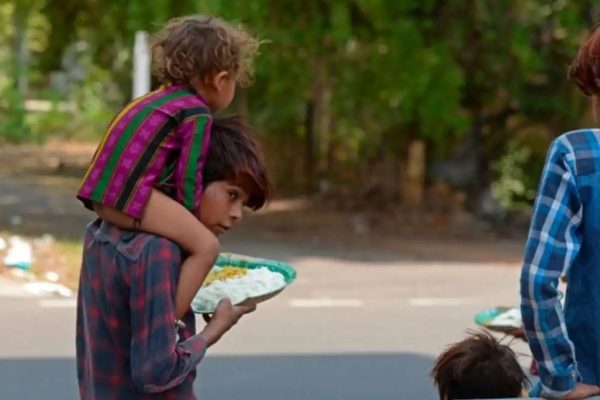World must end power rivalry to ensure food for poor
October 17, 2022 · By Ben Joseph for www.ucanews.com
Poverty has risen, especially in Asia, in aftermath of Covid pandemic and due to Ukraine war

A boy carrying a child and a food plate walks after receiving free food being distributed by a Hindu voluntary organization amid the coronavirus pandemic in Hyderabad on April 26, 2021. (Photo: Noah Seelam/AFP)
World must end power rivalry to ensure food for poor
With the Covid-19 pandemic, whose cause and reasons for its spectacular spread are still shrouded in mystery, and the Ukraine war, the fallout of a great new power rivalry, the first sustainable development goal (SDG) — ending extreme poverty by 2030 — has gone out the window in Asia.
Post-pandemic, unemployment rates in Asia increased as many lost jobs or saw their incomes cut. After the Ukraine war started in February, high inflation became the order of the day in many Asian nations due to skyrocketing energy prices which made food more expensive.
Developing nations and low, and lower-middle-income countries in Asia, could barely offset the impact of the pandemic as they spent less on healthcare and education despite the severe learning losses and health-related setbacks.
Denial of education and healthcare facilities hit girls in Asia hard and they are sure to end up as victims of child marriage and the violence of patriarchal rules.
Interestingly, the world prevented an estimated 25 million child marriages between 2008 and 2018. Nearly half of them were epected to take place on Asian soil.
The neglect of girls’ education and health has sealed the fate of ending child marriage by 2030. The fifth SDG adopted by all United Nations (UN) member states in 2015 is in jeopardy because 10 million more teenage girls are expected to tie the knot by 2030.
“If Covid-19 dealt the biggest blow to Asian nations, the war in Ukraine further aggravated it”
After the UN started its poverty reduction efforts in 1990 with 17 SDGs, the pandemic marked a historic turning point two years ago as the world’s collective GDP fell by 3.4 percent to US$84.54 trillion in 2020 compared with the previous year.
In 2020, at least 71 million more people were reduced to extreme poverty, mainly in Africa and Asia, living on less than $2.15 a day.
The worst-hit Asian nations were: North Korea, Pakistan, Myanmar, Nepal, India, Yemen, Timor-Leste, Syria, Uzbekistan, Kyrgyzstan, and Tajikistan.
If Covid-19 dealt the biggest blow to Asian nations, the war in Ukraine further aggravated it.
After the conflict in started in Eastern Europe, involving Ukraine–a leading wheat-producing nation also called the bread basket of Europe–and Russia–the second largest oil producer and largest exporter of fertilizers–food and oil prices went through the roof in Asia.
Already, South Asia has the second-highest number with 33.4 percent of the world’s extremely poor living in this region, after the Sahara region in Africa.
Despite their economies putting up a robust show, India and Bangladesh hold the dubious distinction of housing half the world’s extreme poor, along with Nigeria, the Democratic Republic of Congo, and Ethiopia in Africa. They are also the most populous nations in South Asia.
To stave off social unrest due to high energy prices, many governments in Asia doled out broad subsidies. But it did not yield the desired results as half of the spending on energy subsidies in Asia’s low and middle-income economies goes to the richest 20 percent of the population because it is they who consume more energy compared with the poor.
The end result is that inequality rose with a deepening gulf between the rich and poor for the first time in decades.
Inequality worsened significantly in China, India, Indonesia, Bangladesh, and Sri Lanka and financial crises started in some of them.
In fact, almost all Asian nations succeeded in reducing extreme poverty dramatically from 1990 through 2019 with better health and educational facilities. Many Asians stood on their feet as their purchasing power increased.
Asia’s poverty rate dropped from 73.6 percent in 1965 to less than 10 percent in 2014 and the decreasing trend continued until the pandemic and Ukraine war wreaked havoc on their national economies.
“Progress in reducing extreme poverty has essentially halted in tandem with subdued global economic growth”
This upward social mobility of Asia, the most populous continent, helped the UN to come out with a new global extreme-poverty line.
Based on the 2017 purchasing-power-parity, the extreme-poverty line was adjusted in 2020 upward to $2.15 a day to reflect the latest progress.
In a report, released this month, the World Bank stated that the world is unlikely to meet the goal of ending extreme poverty by 2030.
The bank’s latest report, “Poverty and Shared Prosperity 2022,” is the first comprehensive look at global poverty in the aftermath of the pandemic and the Ukraine war.
“Progress in reducing extreme poverty has essentially halted in tandem with subdued global economic growth,” said World Bank Group President David Malpass in the report, made public on Oct. 5.
According to the report, extreme poverty will not end within its deadline of 2030 as the Ukraine war added fire to the frying pan after the pandemic did its dirty job, reversing years of progress in poverty reduction forever.
Finding the real reasons behind the pandemic and ending the new power rivalry surely would have ensured food on the plate of the poor by 2030. But that is now a remote possibility.
*The views expressed in this article are those of the author and do not necessarily reflect the official editorial position of UCA News.






